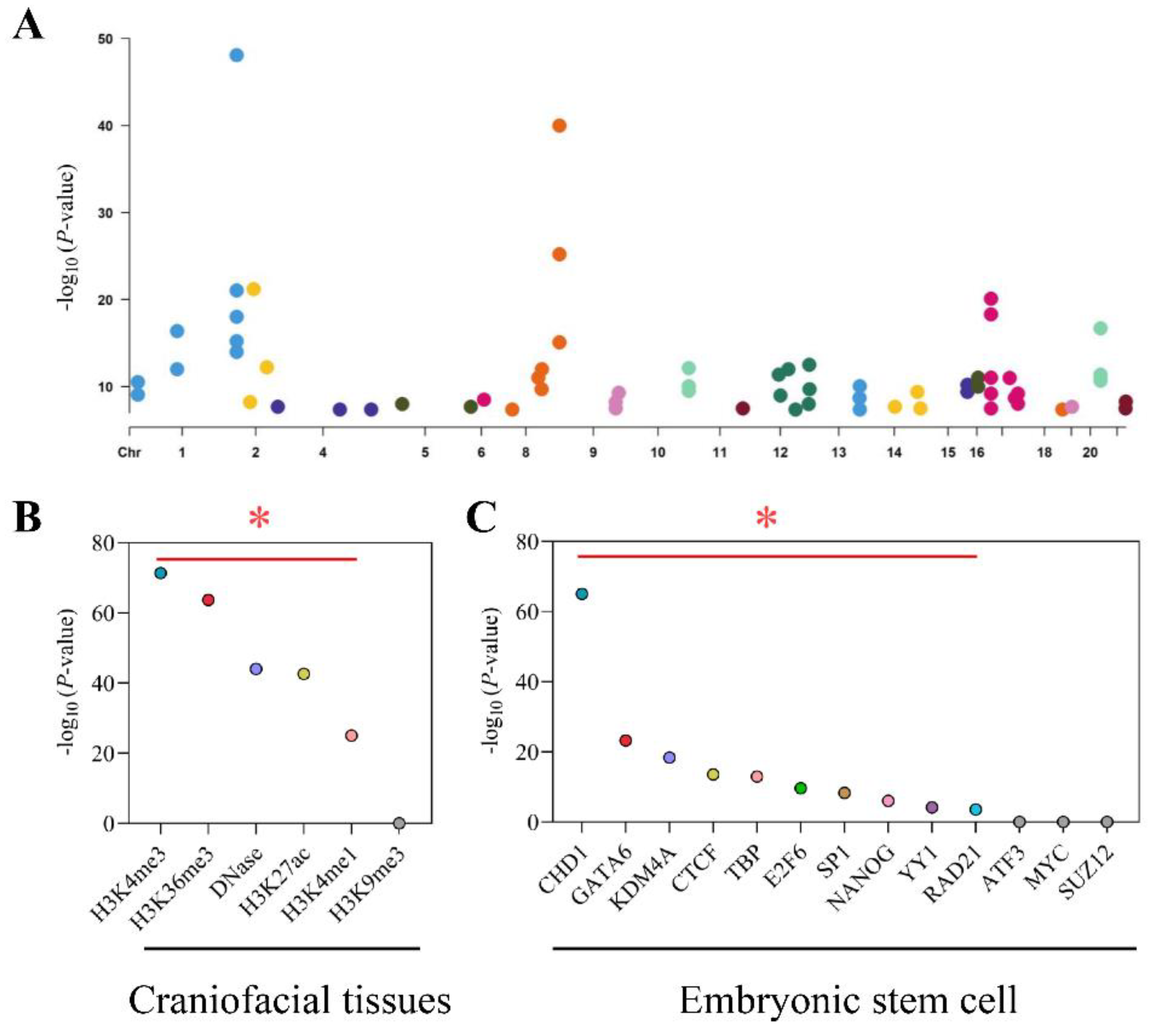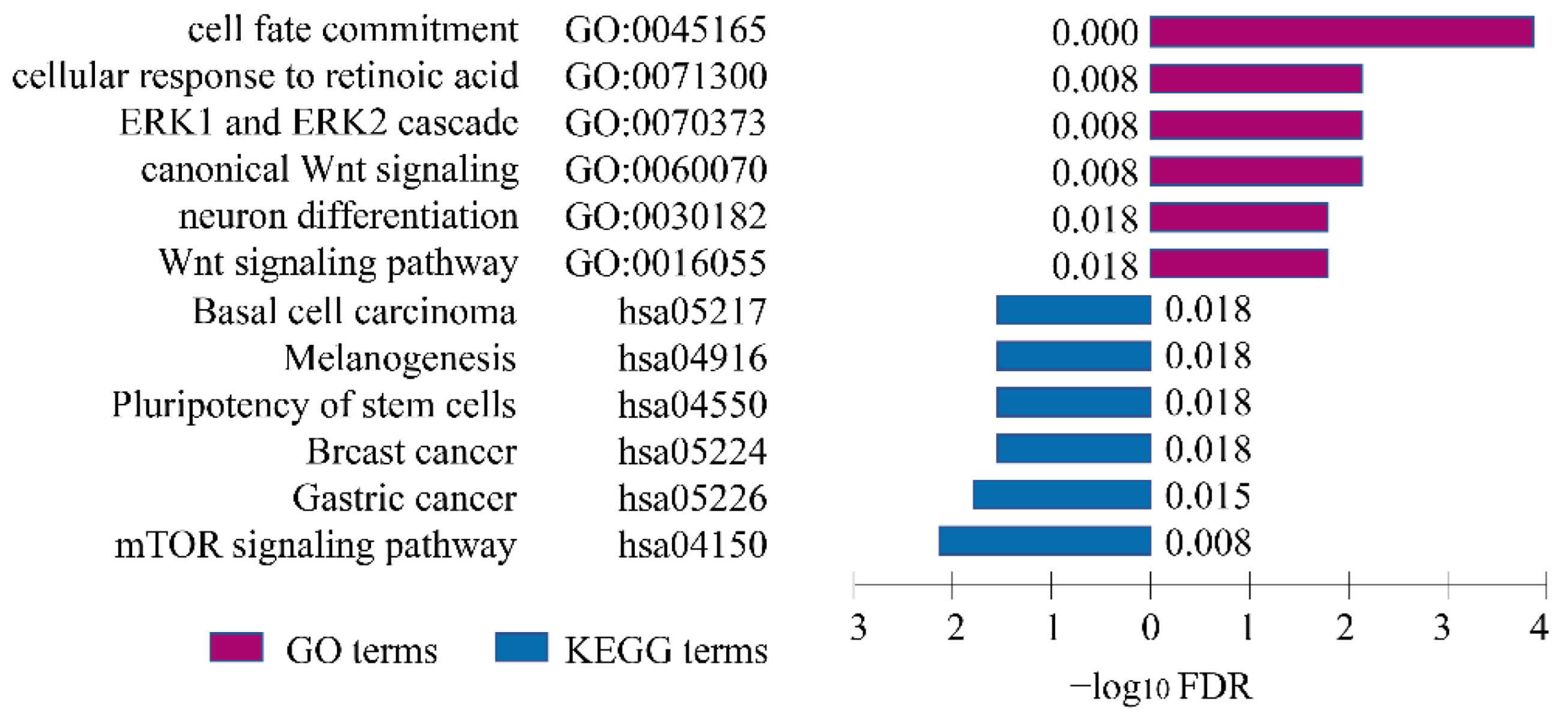Expression Quantitative Trait Locus Study of Non-Syndromic Cleft Lip with or without Cleft Palate GWAS Variants in Lip Tissues
Abstract
:1. Introduction
2. Materials and Methods
2.1. Subjects
2.2. RNA Sequencing and Genotype Data
2.3. eQTL Analysis
2.4. Integrative Analysis of eQTL and GWAS Data
2.5. Histone Mark and Transcription Factor Binding Site Enrichment Analysis
2.6. Differentially Expression Analysis
3. Results
3.1. eQTL Analysis of 40 Lip Tissues from NSCL/P Patients
3.2. Integrative Analysis of Lip eQTL and NSCL/P Risk SNPs
3.3. Risk-eSNPs were Enriched at Regulatory Regions
3.4. Pathway Enrichment Analysis
3.5. Differential Expression Analysis
4. Discussion
Supplementary Materials
Author Contributions
Funding
Institutional Review Board Statement
Informed Consent Statement
Data Availability Statement
Acknowledgments
Conflicts of Interest
References
- Dixon, M.J.; Marazita, M.L.; Beaty, T.H.; Murray, J.C. Cleft lip and palate: Understanding genetic and environmental influences. Nat. Rev. Gen. 2011, 12, 167–178. [Google Scholar] [CrossRef] [PubMed] [Green Version]
- Fell, M.; Dack, K.; Chummun, S.; Sandy, J.; Wren, Y.; Lewis, S. Maternal Cigarette Smoking and Cleft Lip and Palate: A Systematic Review and Meta-Analysis. Cleft Palate-Craniofacial J. 2022, 59, 1185–1200. [Google Scholar] [CrossRef] [PubMed]
- Marazita, M.L.; Field, L.L.; Cooper, M.E.; Tobias, R.; Maher, B.S.; Peanchitlertkajorn, S.; Liu, Y.E. Nonsyndromic cleft lip with or without cleft palate in China: Assessment of candidate regions. Cleft Palate-Craniofacial J. 2002, 39, 149–156. [Google Scholar] [CrossRef] [PubMed]
- Ludwig, K.U.; Böhmer, A.C.; Bowes, J.; Nikolic, M.; Ishorst, N.; Wyatt, N.; Hammond, N.L.; Gölz, L.; Thieme, F.; Barth, S.; et al. Imputation of orofacial clefting data identifies novel risk loci and sheds light on the genetic background of cleft lip ± cleft palate and cleft palate only. Hum. Mol. Genet. 2017, 26, 829–842. [Google Scholar] [CrossRef]
- Beaty, T.H.; Marazita, M.L.; Leslie, E.J. Genetic factors influencing risk to orofacial clefts: Today’s challenges and tomorrow’s opportunities. F1000Research 2016, 5, 2800. [Google Scholar] [CrossRef]
- Mostowska, A.; Gaczkowska, A.; Żukowski, K.; Ludwig, K.U.; Hozyasz, K.K.; Wójcicki, P.; Mangold, E.; Böhmer, A.C.; Heilmann-Heimbach, S.; Knapp, M.; et al. Common variants in DLG1 locus are associated with non-syndromic cleft lip with or without cleft palate. Clin. Genet. 2018, 93, 784–793. [Google Scholar] [CrossRef]
- Yu, Y.; Zuo, X.; He, M.; Gao, J.; Fu, Y.; Qin, C.; Meng, L.; Wang, W.; Song, Y.; Cheng, Y.; et al. Genome-wide analyses of non-syndromic cleft lip with palate identify 14 novel loci and genetic heterogeneity. Nat. Commun. 2017, 8, 14364. [Google Scholar] [CrossRef] [Green Version]
- Edwards, S.L.; Beesley, J.; French, J.D.; Dunning, A.M. Beyond GWASs: Illuminating the dark road from association to function. Am. J. Hum. Genet. 2013, 93, 779–797. [Google Scholar] [CrossRef] [Green Version]
- Lee, I.; Blom, U.M.; Wang, P.I.; Shim, J.E.; Marcotte, E.M. Prioritizing candidate disease genes by network-based boosting of genome-wide association data. Genome Res. 2011, 21, 1109–1121. [Google Scholar] [CrossRef] [Green Version]
- Zhu, Z.; Zhang, F.; Hu, H.; Bakshi, A.; Robinson, M.R.; Powell, J.E.; Montgomery, G.W.; Goddard, M.E.; Wray, N.R.; Visscher, P.M.; et al. Integration of summary data from GWAS and eQTL studies predicts complex trait gene targets. Nat. Genet. 2016, 48, 481–487. [Google Scholar] [CrossRef]
- Ratnapriya, R.; Sosina, O.A.; Starostik, M.R.; Kwicklis, M.; Kapphahn, R.J.; Fritsche, L.G.; Walton, A.; Arvanitis, M.; Gieser, L.; Pietraszkiewicz, A.; et al. Retinal transcriptome and eQTL analyses identify genes associated with age-related macular degeneration. Nat. Genet. 2019, 51, 606–610. [Google Scholar] [CrossRef]
- Yang, J.; Yu, X.; Zhu, G.; Wang, R.; Lou, S.; Zhu, W.; Fu, C.; Liu, J.; Fan, L.; Li, D.; et al. Integrating GWAS and eQTL to predict genes and pathways for non-syndromic cleft lip with or without palate. Oral Dis. 2021, 27, 1747–1754. [Google Scholar] [CrossRef]
- Mullin, B.H.; Zhu, K.; Xu, J.; Brown, S.J.; Mullin, S.; Tickner, J.; Pavlos, N.J.; Dudbridge, F.; Walsh, J.P.; Wilson, S.G. Expression Quantitative Trait Locus Study of Bone Mineral Density GWAS Variants in Human Osteoclasts. J. Bone Miner. Res. 2018, 33, 1044–1051. [Google Scholar] [CrossRef] [Green Version]
- Masotti, C.; Brito, L.A.; Nica, A.C.; Ludwig, K.U.; Nunes, K.; Savastano, C.P.; Malcher, C.; Ferreira, S.G.; Kobayashi, G.S.; Bueno, D.F.; et al. MRPL53, a New Candidate Gene for Orofacial Clefting, Identified Using an eQTL Approach. J. Dent. Res. 2018, 97, 33–40. [Google Scholar] [CrossRef] [Green Version]
- Howie, B.N.; Donnelly, P.; Marchini, J. A flexible and accurate genotype imputation method for the next generation of genome-wide association studies. PLoS Genet. 2009, 5, e1000529. [Google Scholar] [CrossRef] [Green Version]
- Shabalin, A.A. Matrix eQTL: Ultra fast eQTL analysis via large matrix operations. Bioinformatics 2012, 28, 1353–1358. [Google Scholar] [CrossRef] [Green Version]
- Buniello, A.; MacArthur, J.A.L.; Cerezo, M.; Harris, L.W.; Hayhurst, J.; Malangone, C.; McMahon, A.; Morales, J.; Mountjoy, E.; Sollis, E.; et al. The NHGRI-EBI GWAS Catalog of published genome-wide association studies, targeted arrays and summary statistics 2019. Nucleic Acids Res. 2019, 47, D1005–D1012. [Google Scholar] [CrossRef] [Green Version]
- Bu, D.; Luo, H.; Huo, P.; Wang, Z.; Zhang, S.; He, Z.; Wu, Y.; Zhao, L.; Liu, J.; Guo, J.; et al. KOBAS-i: Intelligent prioritization and exploratory visualization of biological functions for gene enrichment analysis. Nucleic Acids Res. 2021, 49, W317–W325. [Google Scholar] [CrossRef]
- Wilderman, A.; VanOudenhove, J.; Kron, J.; Noonan, J.P.; Cotney, J. High-Resolution Epigenomic Atlas of Human Embryonic Craniofacial Development. Cell Rep. 2018, 23, 1581–1597. [Google Scholar] [CrossRef]
- Schmidt, E.M.; Zhang, J.; Zhou, W.; Chen, J.; Mohlke, K.L.; Chen, Y.E.; Willer, C.J. GREGOR: Evaluating global enrichment of trait-associated variants in epigenomic features using a systematic, data-driven approach. Bioinformatics 2015, 31, 2601–2606. [Google Scholar] [CrossRef] [Green Version]
- Kobayashi, G.S.; Alvizi, L.; Sunaga, D.Y.; Francis-West, P.; Kuta, A.; Almada, B.V.; Ferreira, S.G.; de Andrade-Lima, L.C.; Bueno, D.F.; Raposo-Amaral, C.E.; et al. Susceptibility to DNA damage as a molecular mechanism for non-syndromic cleft lip and palate. PLoS ONE 2013, 8, e65677. [Google Scholar] [CrossRef] [PubMed] [Green Version]
- Zepeda-Mendoza, C.; Goodenberger, M.L.; Kuhl, A.; Rice, G.M.; Hoppman, N. Familial segregation of a 5q15-q21.2 deletion associated with facial dysmorphism and speech delay. Clin. Case Rep. 2019, 7, 1154–1160. [Google Scholar] [CrossRef] [Green Version]
- Wyatt, B.H.; Raymond, T.O.; Lansdon, L.A.; Darbro, B.W.; Murray, J.C.; Manak, J.R.; Dickinson, A.J.G. Using an aquatic model, Xenopus laevis, to uncover the role of chromodomain 1 in craniofacial disorders. Genesis 2021, 59, e23394. [Google Scholar] [CrossRef]
- Lan, S.J.; Yang, X.G.; Chen, Z.; Yang, T.Y.; Xiang, C.H.; Zhang, D.; Li, Y.X.; Rong, L. Role of GATA-6 and Bone Morphogenetic Protein-2 in Dexamethasone-Induced Cleft Palate Formation in Institute of Cancer Research Mice. J. Craniofacial Surg. 2016, 27, 1600–1605. [Google Scholar] [CrossRef]
- Lan, S.; Yang, X.; Li, T.; Yang, T.; Rong, L. Dexamethasone Induces Apoptosis of Embryonic Palatal Mesenchymal Cells through the GATA-6/Bone Morphogenetic Protein-2/p38 MAPK Pathway. J. Craniofacial Surg. 2022, 33, 1335–1340. [Google Scholar] [CrossRef]
- Chen, S.; Jia, Z.; Cai, M.; Ye, M.; Wu, D.; Wan, T.; Zhang, B.; Wu, P.; Xu, Y.; Guo, Y.; et al. SP1-Mediated Upregulation of Long Noncoding RNA ZFAS1 Involved in Non-syndromic Cleft Lip and Palate via Inactivating WNT/β-Catenin Signaling Pathway. Front. Cell Dev. Biol. 2021, 9, 662780. [Google Scholar] [CrossRef]
- Chen, R.; Yang, Z.; Liu, J.; Cai, X.; Huo, Y.; Zhang, Z.; Li, M.; Chang, H.; Luo, X.J. Functional genomic analysis delineates regulatory mechanisms of GWAS-identified bipolar disorder risk variants. Genome Med. 2022, 14, 53. [Google Scholar] [CrossRef]
- Maili, L.; Letra, A.; Silva, R.; Buchanan, E.P.; Mulliken, J.B.; Greives, M.R.; Teichgraeber, J.F.; Blackwell, S.J.; Ummer, R.; Weber, R.; et al. PBX-WNT-P63-IRF6 pathway in nonsyndromic cleft lip and palate. Birth Defects Res. 2020, 112, 234–244. [Google Scholar] [CrossRef]
- Rochard, L.; Monica, S.D.; Ling, I.T.; Kong, Y.; Roberson, S.; Harland, R.; Halpern, M.; Liao, E.C. Roles of Wnt pathway genes wls, wnt9a, wnt5b, frzb and gpc4 in regulating convergent-extension during zebrafish palate morphogenesis. Development 2016, 143, 2541–2547. [Google Scholar] [CrossRef] [PubMed] [Green Version]
- Bille, C.; Winther, J.F.; Bautz, A.; Murray, J.C.; Olsen, J.; Christensen, K. Cancer risk in persons with oral cleft—A population-based study of 8093 cases. Am. J. Epidemiol. 2005, 161, 1047–1055. [Google Scholar] [CrossRef]
- Bui, A.H.; Ayub, A.; Ahmed, M.K.; Taioli, E.; Taub, P.J. Association Between Cleft Lip and/or Cleft Palate and Family History of Cancer: A Case-Control Study. Ann. Plast. Surg. 2018, 80, S178–S181. [Google Scholar] [CrossRef] [PubMed]
- Jin, Y.R.; Han, X.H.; Nishimori, K.; Ben-Avraham, D.; Oh, Y.J.; Shim, J.W.; Yoon, J.K. Canonical WNT/β-Catenin Signaling Activated by WNT9b and RSPO2 Cooperation Regulates Facial Morphogenesis in Mice. Front. Cell Dev. Biol. 2020, 8, 264. [Google Scholar] [CrossRef] [PubMed]
- Jezewski, P.A.; Fang, P.K.; Payne-Ferreira, T.L.; Yelick, P.C. Zebrafish Wnt9b synteny and expression during first and second arch, heart, and pectoral fin bud morphogenesis. Zebrafish 2008, 5, 169–177. [Google Scholar] [CrossRef] [Green Version]
- Lan, Y.; Ryan, R.C.; Zhang, Z.; Bullard, S.A.; Bush, J.O.; Maltby, K.M.; Lidral, A.C.; Jiang, R. Expression of Wnt9b and activation of canonical Wnt signaling during midfacial morphogenesis in mice. Dev. Dyn. 2006, 235, 1448–1454. [Google Scholar] [CrossRef] [Green Version]
- Jin, Y.R.; Han, X.H.; Taketo, M.M.; Yoon, J.K. Wnt9b-dependent FGF signaling is crucial for outgrowth of the nasal and maxillary processes during upper jaw and lip development. Development 2012, 139, 1821–1830. [Google Scholar] [CrossRef] [Green Version]
- Ferretti, E.; Li, B.; Zewdu, R.; Wells, V.; Hebert, J.M.; Karner, C.; Anderson, M.J.; Williams, T.; Dixon, J.; Dixon, M.J.; et al. A conserved Pbx-Wnt-p63-Irf6 regulatory module controls face morphogenesis by promoting epithelial apoptosis. Dev. Cell 2011, 21, 627–641. [Google Scholar] [CrossRef] [Green Version]
- Fontoura, C.; Silva, R.M.; Granjeiro, J.M.; Letra, A. Association of WNT9B Gene Polymorphisms with Nonsyndromic Cleft Lip with or without Cleft Palate in Brazilian Nuclear Families. Cleft Palate-Craniofacial J. 2015, 52, 44–48. [Google Scholar] [CrossRef] [Green Version]
- Knutson, B.A.; Hahn, S. Yeast Rrn7 and human TAF1B are TFIIB-related RNA polymerase I general transcription factors. Science 2011, 333, 1637–1640. [Google Scholar] [CrossRef] [Green Version]
- Laity, J.H.; Lee, B.M.; Wright, P.E. Zinc finger proteins: New insights into structural and functional diversity. Curr. Opin. Struct. Biol. 2001, 11, 39–46. [Google Scholar] [CrossRef]
- Li, H.T.; Liu, Y.; Liu, H.; Sun, X. Effect for Human Genomic Variation during the BMP4-Induced Conversion from Pluripotent Stem Cells to Trophoblast. Front. Genet. 2020, 11, 230. [Google Scholar] [CrossRef]
- Traustadóttir, G.; Lagoni, L.V.; Ankerstjerne, L.B.S.; Bisgaard, H.C.; Jensen, C.H.; Andersen, D.C. The imprinted gene Delta like non-canonical Notch ligand 1 (Dlk1) is conserved in mammals, and serves a growth modulatory role during tissue development and regeneration through Notch dependent and independent mechanisms. Cytokine Growth Factor Rev. 2019, 46, 17–27. [Google Scholar] [CrossRef] [PubMed]




Publisher’s Note: MDPI stays neutral with regard to jurisdictional claims in published maps and institutional affiliations. |
© 2022 by the authors. Licensee MDPI, Basel, Switzerland. This article is an open access article distributed under the terms and conditions of the Creative Commons Attribution (CC BY) license (https://creativecommons.org/licenses/by/4.0/).
Share and Cite
Li, X.; Tian, Y.; Qiu, L.; Lou, S.; Zhu, G.; Gao, Y.; Ma, L.; Pan, Y. Expression Quantitative Trait Locus Study of Non-Syndromic Cleft Lip with or without Cleft Palate GWAS Variants in Lip Tissues. Cells 2022, 11, 3281. https://doi.org/10.3390/cells11203281
Li X, Tian Y, Qiu L, Lou S, Zhu G, Gao Y, Ma L, Pan Y. Expression Quantitative Trait Locus Study of Non-Syndromic Cleft Lip with or without Cleft Palate GWAS Variants in Lip Tissues. Cells. 2022; 11(20):3281. https://doi.org/10.3390/cells11203281
Chicago/Turabian StyleLi, Xiaofeng, Yu Tian, Ling Qiu, Shu Lou, Guirong Zhu, Yue Gao, Lan Ma, and Yongchu Pan. 2022. "Expression Quantitative Trait Locus Study of Non-Syndromic Cleft Lip with or without Cleft Palate GWAS Variants in Lip Tissues" Cells 11, no. 20: 3281. https://doi.org/10.3390/cells11203281




